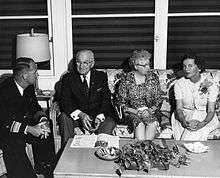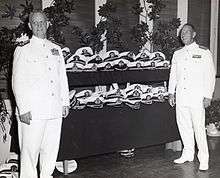Lloyd M. Mustin
| Lloyd Montague Mustin | |
|---|---|
 Vice Admiral Lloyd M. Mustin | |
| Born |
July 30, 1911 Philadelphia, Pennsylvania |
| Died |
January 21, 1999 (aged 87) Coronado, California |
| Place of burial | United States Naval Academy |
| Allegiance |
|
| Service/branch |
|
| Years of service | 1932–1971 |
| Rank |
|
| Commands held |
|
| Battles/wars | |
| Spouse(s) | Emily Proctor Morton |
Lloyd Montague Mustin (1911-1999) was a Vice Admiral in the United States Navy and among the namesakes of USS Mustin (DDG-89). He took part in developing the Navy's first lead-computing anti-aircraft gun sight, which proved of major importance in the air-sea actions of World War II, and he served on the cruiser USS Atlanta during the naval battle of Guadalcanal. His ship was lost during that action, and with other survivors he landed on Guadalcanal and served ashore with a naval unit attached to the First Marine Division. His post war service included commands at sea and development and evaluation of weapon systems. He later served as director of operations for the Joint Chiefs of Staff during the Vietnam War.[1]
Early life and Career
Mustin was born on July 30, 1911 at the Navy Yard, Philadelphia, Pennsylvania to a family steeped in naval tradition. His father, Captain Henry C. Mustin, USN, was a pioneer naval aviator who established the first naval air station and launched the first aircraft from a ship underway. The destroyer USS Mustin (DD-413) was named for him along with the Henry C. Mustin Naval Air Facility and the Mustin Beach Club at NAS Pensacola. Mustin's father died when he was twelve years old and his mother married Vice Admiral George Murray, USN, a close friend and one-time student of Mustin's father. Murray was captain of USS Enterprise (CV-6) during the Battle of Midway and the Doolittle Raid. At the end of the war, he accepted the surrender of Japan in the Marianas on behalf of Commander in Chief, Pacific Fleet and Pacific Ocean Areas.
The destroyer USS Sinclair (DD-275) was named for Mustin's twice great grandfather, Commodore Arthur Sinclair, USN, who commanded the US Naval Squadron on Lake Ontario during the War of 1812. Additionally, his great grandfather, Captain Arthur Sinclair, USN, commanded one of Commodore Perry's ships in the opening of Japan. Mustin's great uncle, LT Arthur Sinclair, fought in CSS Virginia during the Battle of Hampton Roads and in CSS Alabama during her sinking in the Battle of Cherbourg. His maternal uncle was General George Barnett, 12th Commandant of the United States Marine Corps, for whom the attack transport USS Barnett (APA-5) was named.

Mustin entered the United States Naval Academy in 1928. Upon graduation in 1932, he was assigned to the cruiser Augusta (CA 31). She was commanded in Mustin's time by three future four-star admirals, among them Captain Chester W. Nimitz. He carried Nimitz's lessons with him throughout the remainder of his career.
_Wardroom_circa_1932.jpg)
After four years he was transferred to the destroyer Lamson (DD 367), in which he served two years. After instruction in ordnance engineering at the Naval Postgraduate School and the Massachusetts Institute of Technology (MS 1940) he became Assistant Production Officer at the Naval Gun Factory, Washington, DC and took part in developing the Mark 14 gunsight.
At the outbreak of World War II, Mustin was Assistant Gunnery Officer in the cruiser Atlanta (CL 51) and was in her when she was sunk during the Battle for Guadalcanal on the night of 13 November 1942. He received the Fleet Commander's Commendation (with ribbon) for outstanding service in the battles. He landed on Guadalcanal with the survivors and served there for three months with the small naval unit attached to the First Marine Division.[2]
In 1943-1944 he had consecutive duty in the cruisers San Diego (CL 53) and Miami (CL 89). For outstanding service in the latter he received a second fleet commander's commendation. He next served as Gunnery, Radar, and CIC Officer on the staff of Commander Battleship Squadron Two, Vice Admiral Willis A. Lee, Jr., USN, and in the summer of 1945 was with Admiral Lee in establishing the Operational Development Force, as Gunnery, Radar, and CIC Officer.[2]
Post War
After the war, Mustin was ordered to the Navy Department, Washington, DC, for duty as Head of the Fire Control Branch, Research Division, Bureau of Ordnance. This duty was followed by service afloat in command of the destroyer USS Keppler (DD-765) and later as ASW Officer and Readiness Officer on the Staff of Commander Destroyer Force, Atlantic. Between 1951 and 1954 he was assigned to the Weapons System Evaluation Group, Office of the Secretary of Defense, and after command of the destroyer tender Piedmont (AD 17), had command of Cruiser-Destroyer Force, Pacific, from April 1957 until May 1958, when he reported as Commander Destroyer Flotilla Two.[2]
While so serving he had additional duty from May to October 1958, in command of Task Force 88, a special task force organized to plan and conduct the Argus high-altitude nuclear tests which were fired in a remote part of the South Atlantic. In October 1958 he assumed additional duty in command of Antisubmarine Defense Group "Charlie", and from February through April 1959 commanded Task force 88 conducting combined ASW training operations with the navies and air forces of the countries on the west coast of South America.[2]

On 13 June 1959, he became Commander Naval Base, Key West, and Commander Key West Force and in May 1960 reported for duty in the Office of the Chief of Naval Operations, first as Antisubmarine Readiness Executive and then as Director of Antisubmarine Warfare.[2]
On 30 November 1961, he reported to Joint Task Force Eight as Deputy Task Force Commander and Commander Joint Task Group 8.3, to plan and conduct the Dominic series of nuclear tests in the Pacific. On 2 November 1962, he was designated Commander, Joint Task Force Eight, to conduct the remaining Dominic tests and to plan for and conduct future nuclear tests.[2]

On 1 June 1964, he became Director for Operations, J-3, Joint Staff, Joint Chiefs of Staff, Washington, DC. In May 1967 he became Commander Amphibious Force, US Atlantic Fleet and in July 1968 assumed duty as Director of the Defense Atomic Support Agency, Washington, DC. He served in that capacity until relieved of active duty pending his retirement, effective 1 August 1971.[2]
Post-Retirement
After leaving the Navy, Mustin served as president of the National Rifle Association 1977–1978.[3]
Promotions
- Midshipman - 14 June 1928
- Ensign - 2 June 1932
- Lieutenant (junior grade) - 2 June 1935
- Lieutenant - 1 July 1939
- Lieutenant Commander - 15 June 1942
- Commander - 1 November 1943 to date from 18 November 1942
- Captain - 1 January 1951
- Rear Admiral - 1 July 1958
- Vice Admiral - 21 August 1964
Commemoration
The U.S. Navy guided-missile destroyer USS Mustin (DDG-89) is named for the Mustin family.
References
- ↑ "Named to honor the Mustin family". www.public.navy.mil. Retrieved 2016-01-29.
 This article incorporates text from this source, which is in the public domain.
This article incorporates text from this source, which is in the public domain. - 1 2 3 4 5 6 7 "Mustin, Lloyd M.". www.history.navy.mil. Retrieved 2016-02-01.
 This article incorporates text from this source, which is in the public domain.
This article incorporates text from this source, which is in the public domain. - ↑ Rodengen, Jeffrey L. (2002). NRA: An American Legend. Fort Lauderdale, Florida: Write Stuff Enterprises, Inc. 304 pp. ISBN 0-945903-81-2. ("The Presidents of NRA", p. 276).